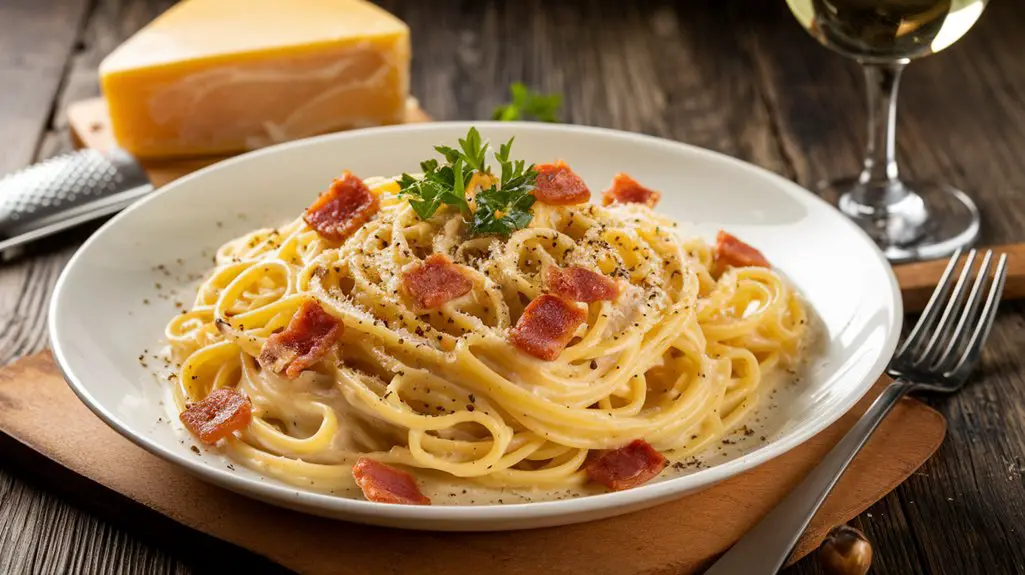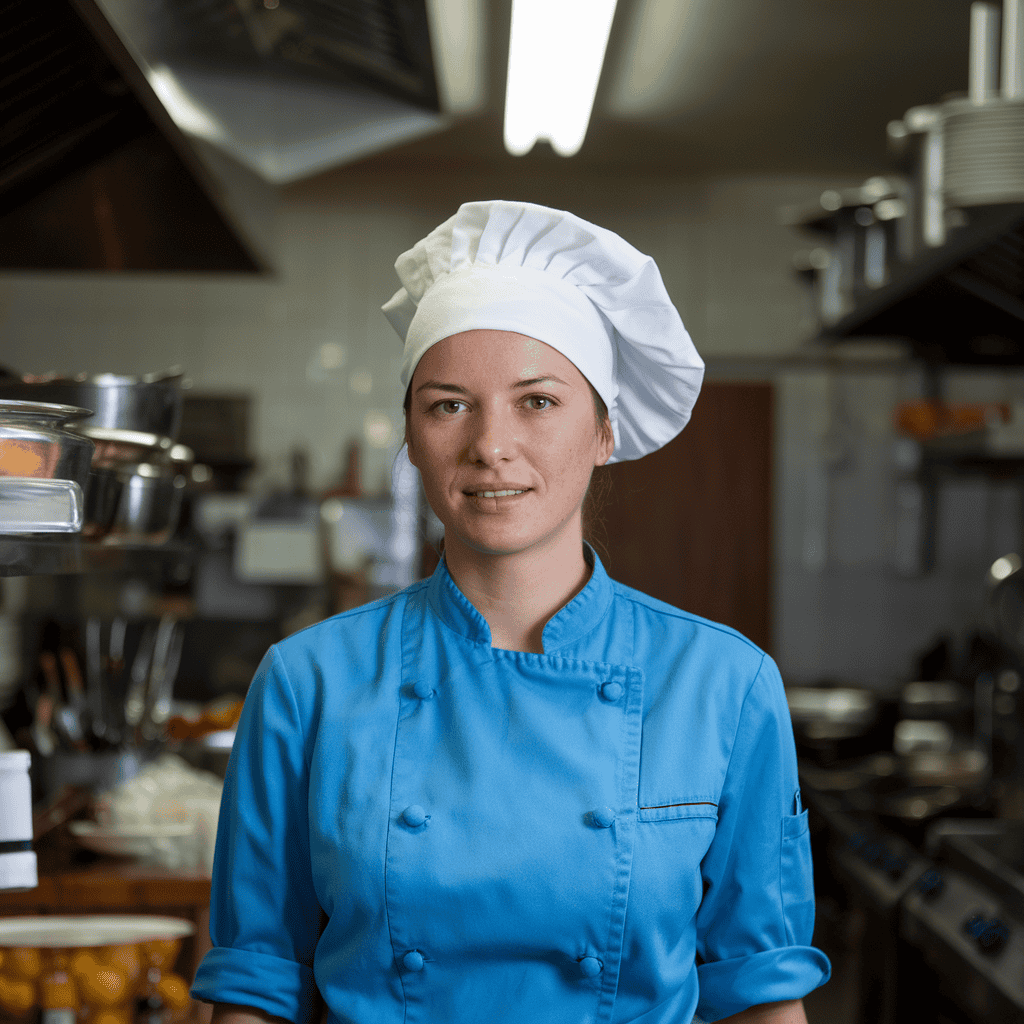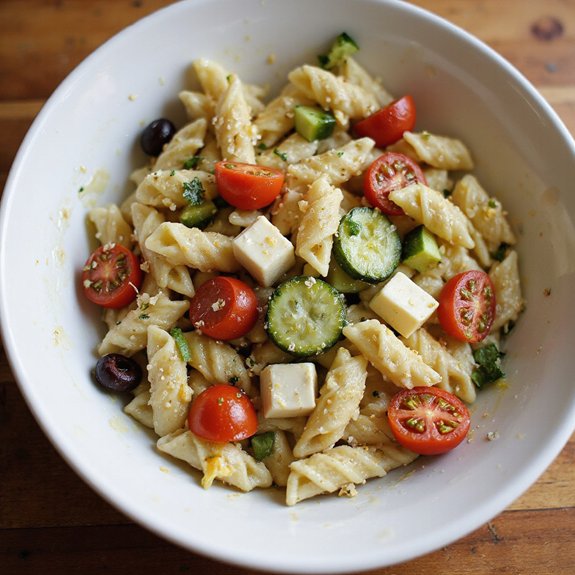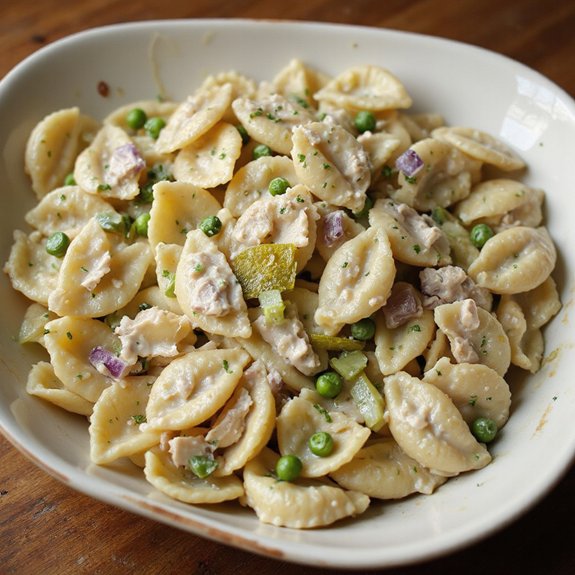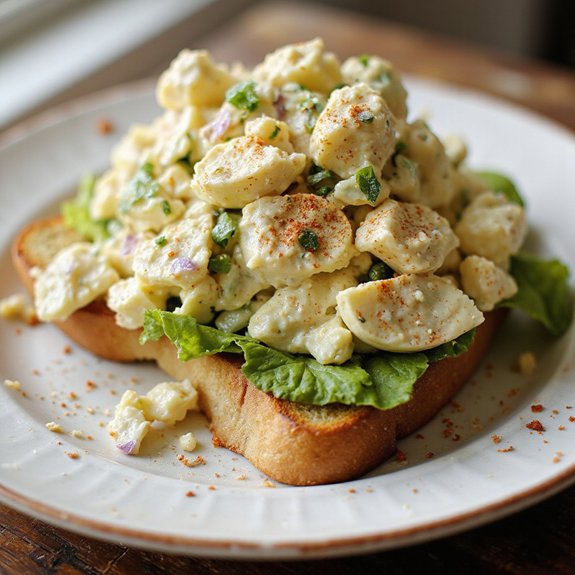When preparing Carbonara Pasta, you’ll focus on executing precise steps to achieve its renowned creamy texture.
Begin by gathering quality ingredients like Pecorino Romano and pancetta, and guarantee your timing is impeccable to prevent the eggs from scrambling.
By mastering the balance of heat and technique, you can transform simple ingredients into an elegant dish.
Are you ready to elevate your pasta skills and explore the art of Carbonara further?
Kitchen Tools Required
To prepare a perfect Carbonara Pasta, you’ll need a few essential kitchen tools that guarantee efficiency and precision.
First, a large pot is fundamental for boiling the spaghetti to al dente perfection.
A sharp knife will help you slice the pancetta or guanciale evenly, ensuring uniform crispiness.
Use a sturdy skillet to render the fat from the meat, allowing for even heat distribution.
A whisk is critical for blending the eggs and cheese into a smooth mixture.
Finally, a pair of tongs will help you toss the pasta and sauce together seamlessly.
| Tool | Purpose | Material |
|---|---|---|
| Large Pot | Boil pasta | Stainless Steel |
| Sharp Knife | Slice pancetta or guanciale | Carbon Steel |
| Sturdy Skillet | Cook pancetta evenly | Cast Iron |
| Whisk | Blend eggs and cheese | Stainless Steel |
Recipe
Carbonara Pasta is a timeless Italian classic that relies on the simplicity of its ingredients to deliver a rich and satisfying meal.
The dish is known for its creamy sauce, which is created without the use of cream, instead relying on the combination of eggs and Pecorino Romano cheese.
The addition of pancetta or guanciale provides a savory counterpoint, while freshly ground black pepper adds a subtle kick.
Perfect for a cozy dinner or a special occasion, Carbonara Pasta is both indulgent and easy to prepare, making it a favorite for many home cooks.
The origins of this beloved dish are subject to debate, with some tracing it back to Italian coal miners and others attributing it to the influence of American soldiers during World War II.
Regardless, Carbonara Pasta has become a staple in Italian cuisine and a must-try for any pasta enthusiast.
The key to a successful Carbonara lies in achieving the perfect balance of flavors and confirming that the pasta is thoroughly coated with the velvety sauce.
Using high-quality ingredients can greatly enhance the overall taste, making this dish a delightful culinary experience.
Ingredients:
- Spaghetti
- Pancetta or guanciale
- Eggs
- Pecorino Romano cheese
- Black pepper
- Salt
To prepare Carbonara Pasta, begin by boiling a pot of salted water and cooking the spaghetti until it reaches an al dente texture.
While the pasta is cooking, slice the pancetta or guanciale into small pieces and cook them in a large skillet over medium heat until they’re crisp.
In a separate bowl, whisk together the eggs and grated Pecorino Romano cheese, incorporating a generous amount of freshly ground black pepper.
Once the spaghetti is cooked, reserve some of the pasta water, then drain the spaghetti and add it to the skillet with the pancetta.
Remove the skillet from the heat and quickly pour the egg and cheese mixture over the pasta, stirring vigorously to create a creamy sauce.
If needed, add a small amount of the reserved pasta water to reach the desired consistency.
Serve immediately with additional cheese and black pepper as garnish.
When making Carbonara Pasta, it’s essential to work swiftly when mixing the hot pasta with the egg and cheese mixture.
The heat from the pasta will gently cook the eggs, resulting in a smooth and creamy sauce without scrambling.
Confirm that the pasta is hot enough to cook the eggs but not so hot that they curdle.
Using fresh eggs and authentic Pecorino Romano cheese will greatly enhance the flavor of the dish.
If pancetta or guanciale is unavailable, good quality bacon can be used as a substitute, though note that this may alter the traditional taste slightly.
Enjoy your Carbonara Pasta with a glass of wine for a truly delectable dining experience.
Cook & Prep Time
When preparing Carbonara Pasta, understanding the cook and prep time is essential for achieving the dish’s perfect texture and flavor.
Allocate about 20 minutes in total, with 10 minutes dedicated to preparation and another 10 for cooking.
Start by filling your pot with water and bringing it to a rolling boil.
Meanwhile, slice your pancetta or guanciale into small, uniform pieces to guarantee even cooking.
As the pasta cooks, whisk the eggs and cheese until smooth.
The key is synchronizing these tasks so that the pasta and pancetta finish simultaneously.
This timing guarantees the pasta’s heat seamlessly transforms the egg mixture into a creamy sauce.
By adhering to these timings, you’ll create an authentic carbonara with ideal texture and taste.
Cooking Steps
To begin crafting Carbonara Pasta, fill a pot with water, add salt, and bring it to a rolling boil for cooking the spaghetti until al dente.
Meanwhile, cut the pancetta into small pieces and cook them in a skillet over medium heat until they’re crisp.
In a separate bowl, whisk together eggs and Pecorino Romano cheese, then swiftly combine the hot pasta with the pancetta before stirring in the egg mixture to form a creamy sauce.
Step 1. Boil Salted Water
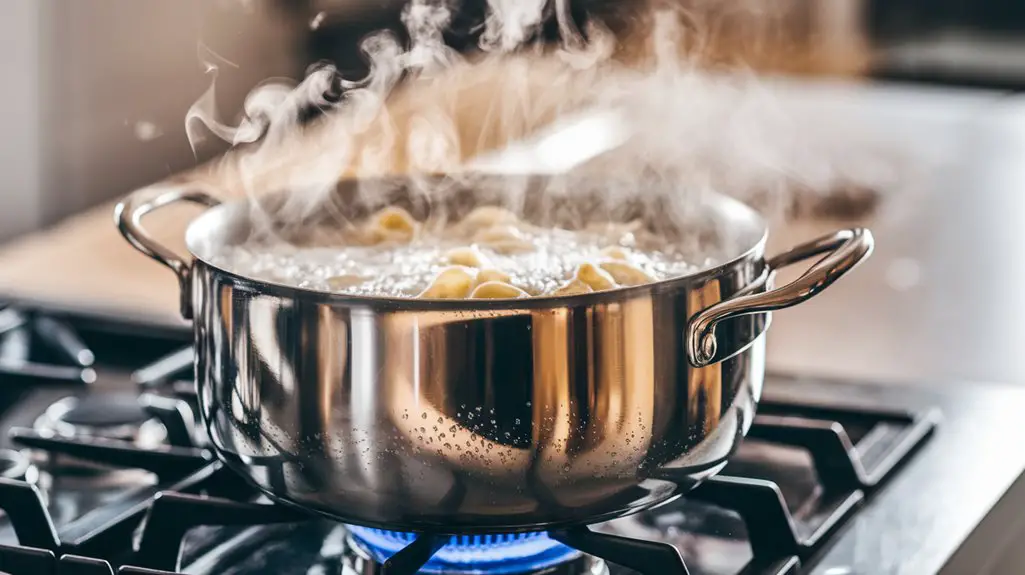
Begin by filling a large pot with water, guaranteeing it’s enough to fully submerge the spaghetti.
Place the pot over high heat and wait for it to reach a rolling boil. Once boiling, add a generous tablespoon of salt.
The salt not only seasons the pasta but also enhances its texture.
Stir the water briefly to help dissolve the salt completely before adding the spaghetti.
Gently lower the pasta into the pot, ensuring it’s fully immersed.
As it softens, use tongs to separate any clumps, allowing the strands to cook evenly.
Maintain a steady boil to guarantee the pasta cooks at a consistent temperature.
This step is vital for achieving the perfect al dente texture, essential for a successful carbonara.
Step 2. Crisp Pancetta in Skillet

Place a large skillet over medium heat, allowing it to warm up before adding the pancetta or guanciale.
Cut the meat into small, uniform pieces to guarantee even cooking. Add them to the skillet and let the fat render gradually, stirring occasionally.
It’s vital to maintain a consistent heat to achieve a crispy texture without burning.
| Technique | Result |
|---|---|
| Medium Heat | Even Cooking |
| Uniform Pieces | Consistent Texture |
| Occasional Stirring | Prevents Burning |
Keep an eye on the color; the pancetta should turn golden brown.
Once crisp, remove the skillet from heat, letting the residual warmth finish the process.
Timing is fundamental here, as overcooking can lead to a chewy texture, detracting from the dish’s overall quality.
Step 3. Mix Eggs With Pecorino Cheese
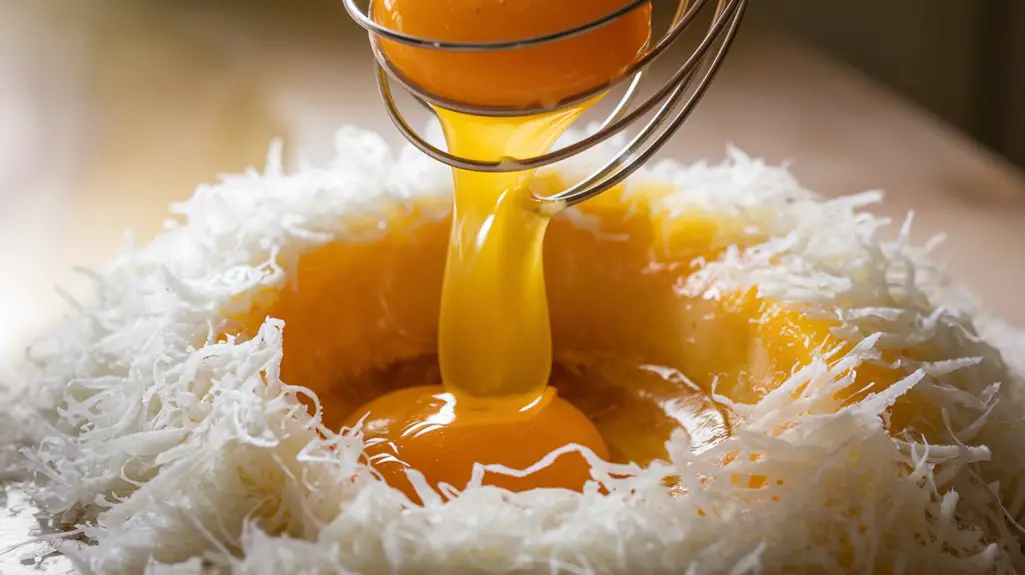
Whisk the eggs vigorously with Pecorino Romano cheese in a large mixing bowl to create a smooth, cohesive mixture.
This step is essential for achieving the creamy texture characteristic of Carbonara.
Use a fork or whisk to break the yolks, ensuring the cheese integrates fully. Aim for a uniform consistency without lumps.
- Eggs: Use fresh, large eggs for ideal flavor and texture.
- Cheese: Grate Pecorino Romano finely, allowing it to blend seamlessly.
- Ratio: Maintain a balanced egg-to-cheese ratio for a rich sauce.
- Seasoning: Add freshly ground black pepper for depth.
Ensure the mixture is ready before the pasta finishes cooking.
This precise timing allows for the immediate incorporation of the mixture with hot pasta, vital in preventing the eggs from scrambling.
Step 4. Combine Pasta With Pancetta

As the egg and cheese mixture stands ready, focus shifts to the pasta and pancetta.
Begin by making sure your spaghetti is cooked al dente; it should have a firm bite. Drain the pasta, reserving some of the cooking water.
In a large skillet over medium heat, the pancetta should be sizzling, crispy, and golden brown. This process should take about 5-7 minutes.
Once crispy, remove the skillet from the heat to prevent further cooking.
Quickly add the drained spaghetti to the pancetta, tossing to evenly coat the strands in the rendered fat.
This step guarantees the pasta absorbs the pancetta’s savory flavors.
Maintain a steady hand, making sure the pasta doesn’t sit too long, as timing is vital for the next steps.
Step 5. Stir in Egg Mixture Quickly
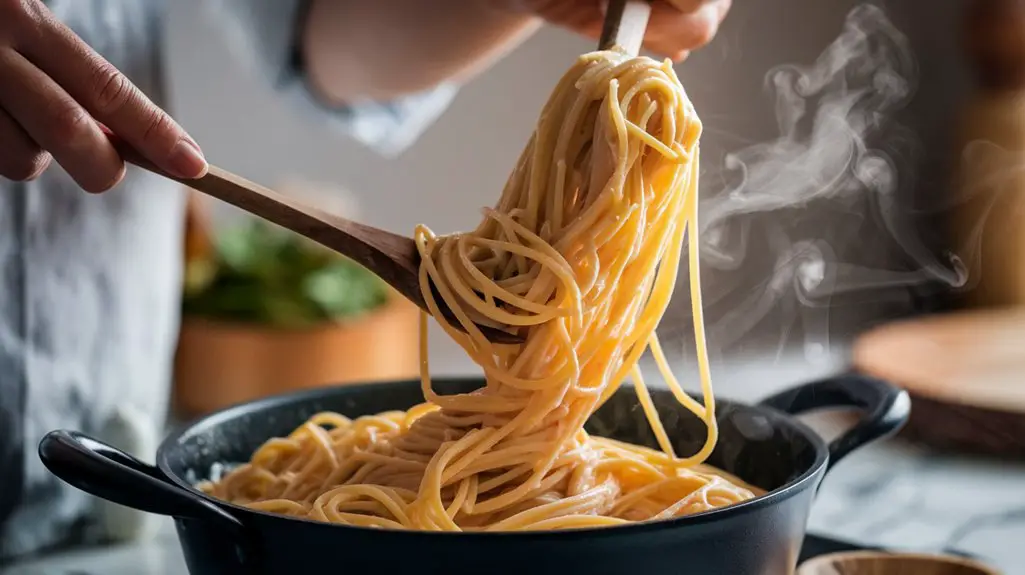
Swiftly transfer the hot spaghetti into the skillet with the pancetta, then immediately pour the egg and cheese mixture over the pasta.
Stir vigorously with tongs or a fork to guarantee the creamy sauce evenly coats every strand.
Keep the skillet off the heat to prevent scrambling. The residual heat from the pasta will gently cook the eggs, creating a luscious, velvety sauce.
Add reserved pasta water gradually if the sauce seems too thick, achieving your desired consistency.
- Avoid overheating: Keeps eggs from scrambling.
- Use tongs: Guarantees even coating.
- Monitor consistency: Add pasta water as needed.
- Work quickly: Maintains the sauce’s smooth texture.
This precise technique guarantees your carbonara remains creamy and authentic, capturing the essence of traditional Italian cuisine.
Nutrition Information
A plate of Carbonara Pasta isn’t just a feast for the senses; it’s also a nutritional profile worth noting.
The dish delivers a balanced mix of macronutrients, offering energy and essential nutrients.
You’ll find that a typical serving provides carbohydrates from the pasta, proteins from the eggs, and fats from the pancetta or guanciale.
Here’s a quick glance at the nutritional breakdown for one serving (approximately 300g):
| Nutrient | Amount per Serving |
|---|---|
| Calories | 600 kcal |
| Carbohydrates | 65 g |
| Protein | 25 g |
| Total Fat | 24 g |
| Saturated Fat | 8 g |
This classic dish not only satisfies your appetite but also provides a hearty meal packed with flavor and sustenance.
Final Thoughts
When preparing Carbonara Pasta, attention to detail guarantees a successful dish.
Start with high-quality ingredients like fresh eggs, Pecorino Romano, and pancetta or guanciale.
Timing is vital—cook the pasta until al dente and reserve some pasta water.
As the pasta drains, make sure the pancetta crisps perfectly.
Quickly combine the hot pasta with the egg-cheese mixture, stirring vigorously to prevent scrambling.
Adjust the sauce’s consistency with reserved water for creaminess. Remember, the pasta’s heat should gently cook the eggs.
Taste and season with additional black pepper if needed. Serve immediately for the best texture and flavor.
With precision and care, your Carbonara Pasta will be a delightful, authentic experience, echoing its rich Italian heritage. Enjoy your culinary creation!
Frequently Asked Questions
What Is the Origin Story of Carbonara Pasta?
You’ll encounter two main origin stories: Italian coal miners creating it as a hearty meal, or American soldiers in Italy during WWII influencing its development. Both theories highlight its evolution into a quintessential Italian pasta dish.
Can Carbonara Be Made Vegetarian?
You can make carbonara vegetarian by replacing pancetta or guanciale with smoked tempeh or mushrooms. Guarantee you maintain the creamy texture by using eggs and cheese, and adjust seasoning to suit your taste for an authentic experience.
How Can I Prevent the Eggs From Scrambling?
Quickly remove the pan from heat before adding eggs. Stir vigorously while incorporating the eggs with hot pasta, allowing residual heat to cook them gently. Avoid direct heat to prevent scrambling, ensuring a smooth, creamy consistency.
What Wine Pairs Best With Carbonara Pasta?
Pair your dish with a crisp Italian white wine like Pinot Grigio or a light red such as Chianti. These wines complement the creamy texture and balance the savory flavors perfectly, enhancing your dining experience.
Can I Use Parmesan Instead of Pecorino Romano Cheese?
Yes, you can substitute Parmesan for Pecorino Romano. However, expect a milder flavor and less sharpness. Adjust salt levels carefully since Parmesan is less salty. Grate finely for ideal melting and guarantee even distribution throughout the dish.

